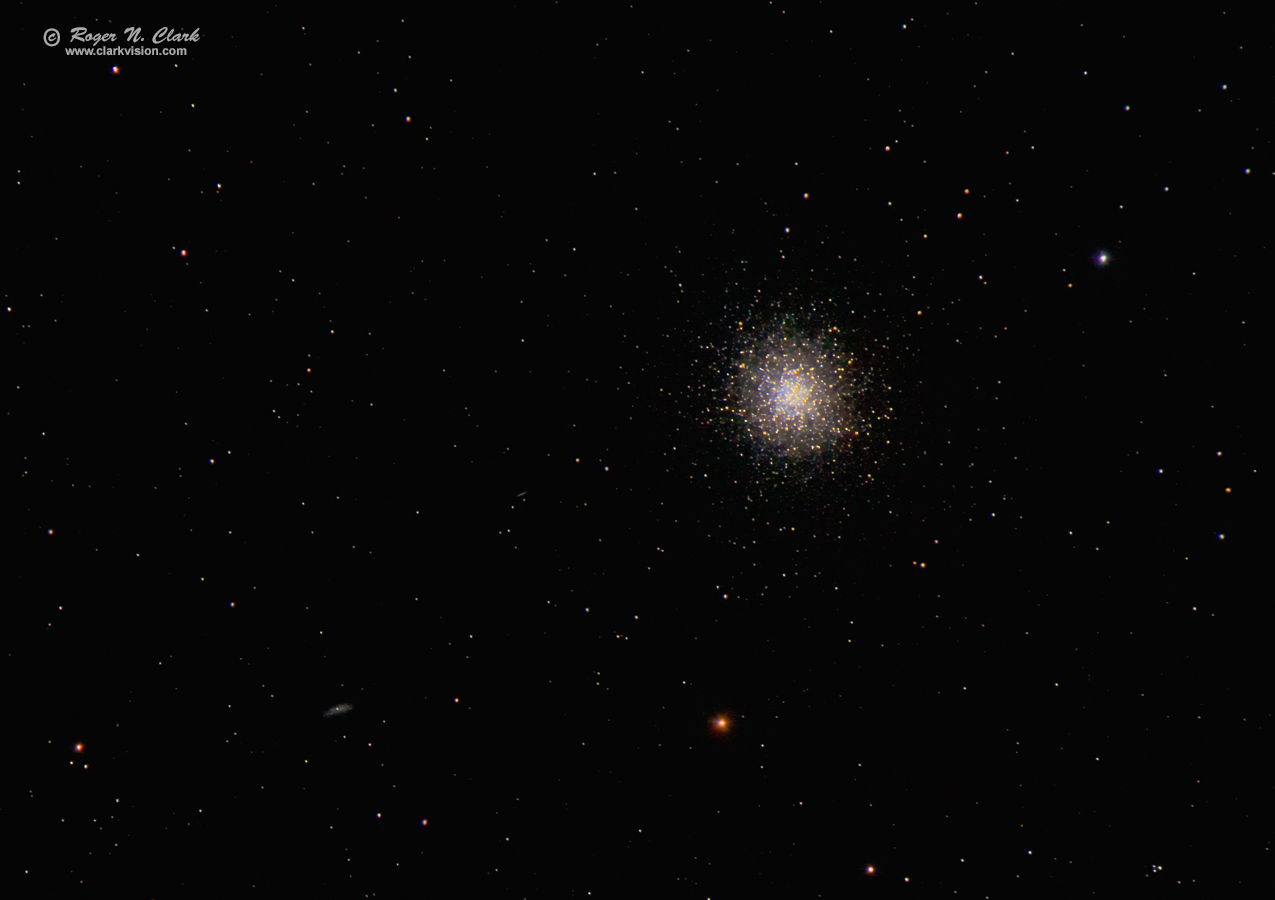| Home | Galleries | Articles | Reviews | Best Gear | New | About | Contact | Gallery Index | Previous |
Next |

| Home | Galleries | Articles | Reviews | Best Gear | New | About | Contact | Gallery Index | Previous |
Next |

Messier 13 is a globular star cluster in the constellation Hercules. M13 contains several hundred thousand stars, mostly white, yellow and red, and only a few blue stars. M13 is about 25,100 light-years from Earth and is about 145 light-years in diameter.
In the image, to the lower left is NGC 6207, a 12th magnitude edge-on galaxy. About half way between M13 and NGC 6207, just above the line connecting these two objects is the small galaxy IC 4617. North is to the left in the image.
The image was made when the cluster was only 20 degrees high in the sky. It shows the view similar to that in a large amateur telescope, about 12-inches aperture. In amateur telescopes, the tens-of thousands of faint stars in the cluster form a background glow, seen here as the yellow-gray. In large telescopes the red giant stars provide a beautiful sight. In a 31-inch aperture telescope, I have seen these stars appear blood red due to their contrast with the hotter yellow to white stars in the background.
Technical. Canon 1D Mark IV 16-megapixel digital camera, Canon 300 mm f/2.8 lens at f/2.8, ISO 1600. Eleven 60-second exposures (11 minutes). No dark frame subtraction, no flat fields. Tracking with an astrotrac and no guiding. Due to the low altitude, I also had to correct for significant differential atmospheric refraction which spread the stars out into little rainbows. The correction is not perfect. The image shown here is 2/3 of full resolution. Image from December 28, 2013. Today, I would make this image with a Canon 7D Mark II 20-megapixel digital camera and 300 mm f/2.8 L IS II lens plus a 2x teleconverter, with the object high in the sky, and that would provide much higher resolution, resolving more stars.
Post processing: stretched with rnc-color-stretch. Also see Astrophotography Image Processing Basic Work Flow.
This is a natural color image. The high dynamic range of astrophotos must be stretched to bring out the range of details the camera recorded. But the typical image stretch process loses color for brighter subjects (e.g. stars and the brighter parts of deep sky objects become whiter as they are made brighter). This image uses a new algorithm, rnc-color-stretch that does not lose color during the stretch. How do we know the colors are reasonable? The star colors can be checked against stellar photometry. Faint red stars have B-V > 2 (not the orange stars, which have B-V of 1 to about 2). The blue-white stars have B-V in the range of 0 to -0.5. The colors closely follow the color sequence in Table 1 at Color of Stars. Solar-type stars have a B-V of 0.63 and appear close to white (daylight white balance).
The Exposure Factors, CEF, CEFA are measures of the relative amounts of light received from a subject. It can be used to fairly compare wildly different lens/telescope apertures and exposure times. For this image:
Modern DSLRs like the 1D Mark IV include on sensor dark current suppression and low fixed pattern noise at ISOs around 1600 and higher, making no need for dark frame subtraction. Modern raw converters correct for light fall-off and also correct for hot/dead/stuck pixels. This makes processing low light images easy: simply align and average.
To learn how to obtain stunning images like this, please visit my Extensive Articles on Photography .
Keywords to this image = astrophoto-1 star_cluster Messier digital_astro rnc-color-stretch canon_1d4
Image ID: m13.600mm1d4.c12.28.2013.C45I1225-38av11-rs20,2.f-.1275s.jpg
| Home | Galleries | Articles | Reviews | Best Gear | Science | New | About | Contact |
Last updated November 08, 2025